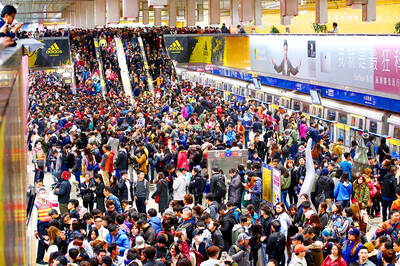President Ma Ying-jeou (馬英九) yesterday urged the next president to refrain from being “ungrateful” for his efforts and to “cherish” the “bridge of peace” that he has built across the Taiwan Strait in the past seven years.
“I hope the cross-strait policies of the next administration will continue in the right direction, following the pragmatic and effective policies that we have implemented in the past seven years,” Ma said in his New Year address, as the Jan. 16 presidential election is expected to result in a change in government.
Ma said he built a “bridge of peace” in his Nov. 7 meeting with Chinese President Xi Jinping (習近平) in Singapore, adding that it is not only a bridge across the Taiwan Strait, but one that also crosses the “barricades of history,” urging the next president to cherish the accomplishment and “not be ungrateful for my efforts.”
“Since the beginning of my first term, the two sides of the Taiwan Strait have created a cooperative model through reconciliation and exchanges, ushering in the most stable and peaceful period in cross-strait relations since the two sides came under separate rule 66 years ago,” Ma said.
He said that all three presidential candidates proposed to maintain the “status quo” and said that this has “never happened before.”
Maintaining the “status quo” is what he described as the “Taiwan consensus,” and the so-called “1992 consensus” is the basis for cross-strait interactions, Ma said.
The “1992 consensus” refers to a tacit understanding between the Chinese Nationalist Party (KMT) and the Chinese government that both sides of the Taiwan Strait acknowledge there is “one China,” with each side having its own interpretation of what “China” means.
The cross-strait “status quo,” based on the “1992 consensus,” has garnered public support and is an important asset for cross-strait peace and regional stability, Ma said.
It is impossible to say “maintain the ‘status quo’” and “abide by the Constitution” on one hand and not accept the “1992 consensus” on the other, Ma said, adding that the consensus comforms with the Constitution of the Republic of China.
He said that cross-strait peace would be achieved gradually and should not be taken for granted.
The peace and prosperity that Taiwan enjoys today were unimaginable during the 1996 Taiwan Strait missile crisis and the conflict and antagonism of 2006 under the administration of then-President Chen Shui-bian (陳水扁), Ma said.
“I sincerely hope that the next administration will be wise and handle things with caution and not misjudge the situation, thereby subjecting the people of Taiwan to turmoil and fear,” he said.
Additional reporting by: Loa Iok-sin

People can take the Taipei MRT free of charge if they access it at Nanjing Sanmin Station or Taipei Arena Station on the Green Line between 12am and 6am on Jan. 1, the Taipei Department of Transportation said on Friday, outlining its plans to ease crowding during New Year’s events in the capital. More than 200,000 people are expected to attend New Year’s Eve events in Taipei, with singer A-mei (張惠妹) performing at the Taipei Dome and the city government’s New Year’s Eve party at Taipei City Hall Plaza, the department said. As people have tended to use the MRT’s Blue or

Civil society groups yesterday protested outside the Legislative Yuan, decrying Chinese Nationalist Party (KMT) efforts to pass three major bills that they said would seriously harm Taiwan’s democracy, and called to oust KMT caucus whip Fu Kun-chi (傅?萁). It was the second night of the three-day “Bluebird wintertime action” protests in Taipei, with organizers announcing that 8,000 people attended. Organized by Taiwan Citizen Front, the Economic Democracy Union (EDU) and a coalition of civil groups, about 6,000 people began a demonstration in front of KMT party headquarters in Taipei on Wednesday, organizers said. For the third day, the organizers asked people to assemble

Taipei is participating in Osaka’s Festival of Lights this year, with a 3m-tall bubble tea light installation symbolizing Taiwan’s bubble tea culture. The installation is designed as a bubble tea cup and features illustrations of Taipei’s iconic landmarks, such as Taipei 101, the Red House and North Gate, as well as soup dumplings and the matchmaking deity the Old Man Under the Moon (月下老人), affectionately known as Yue Lao (月老). Taipei and Osaka have collaborated closely on tourism and culture since Taipei first participated in the festival in 2018, the Taipei City Department of Information and Tourism said. In February, Osaka represented

Taiwanese professional baseball should update sports stadiums and boost engagement to enhance fans’ experience, Chinese Professional Baseball League (CPBL) commissioner Tsai Chi-chang (蔡其昌) told the Liberty Times (sister paper of the Taipei Times) in an interview on Friday. The league has urged Farglory Group and the Taipei City Government to improve the Taipei Dome’s outdated equipment, including relatively rudimentary television and sound systems, and poor technology, he said. The Tokyo Dome has markedly better television and sound systems, despite being 30 years old, because its managers continually upgraded its equipment, Tsai said. In contrast, the Taipei Dome lacked even a room for referees